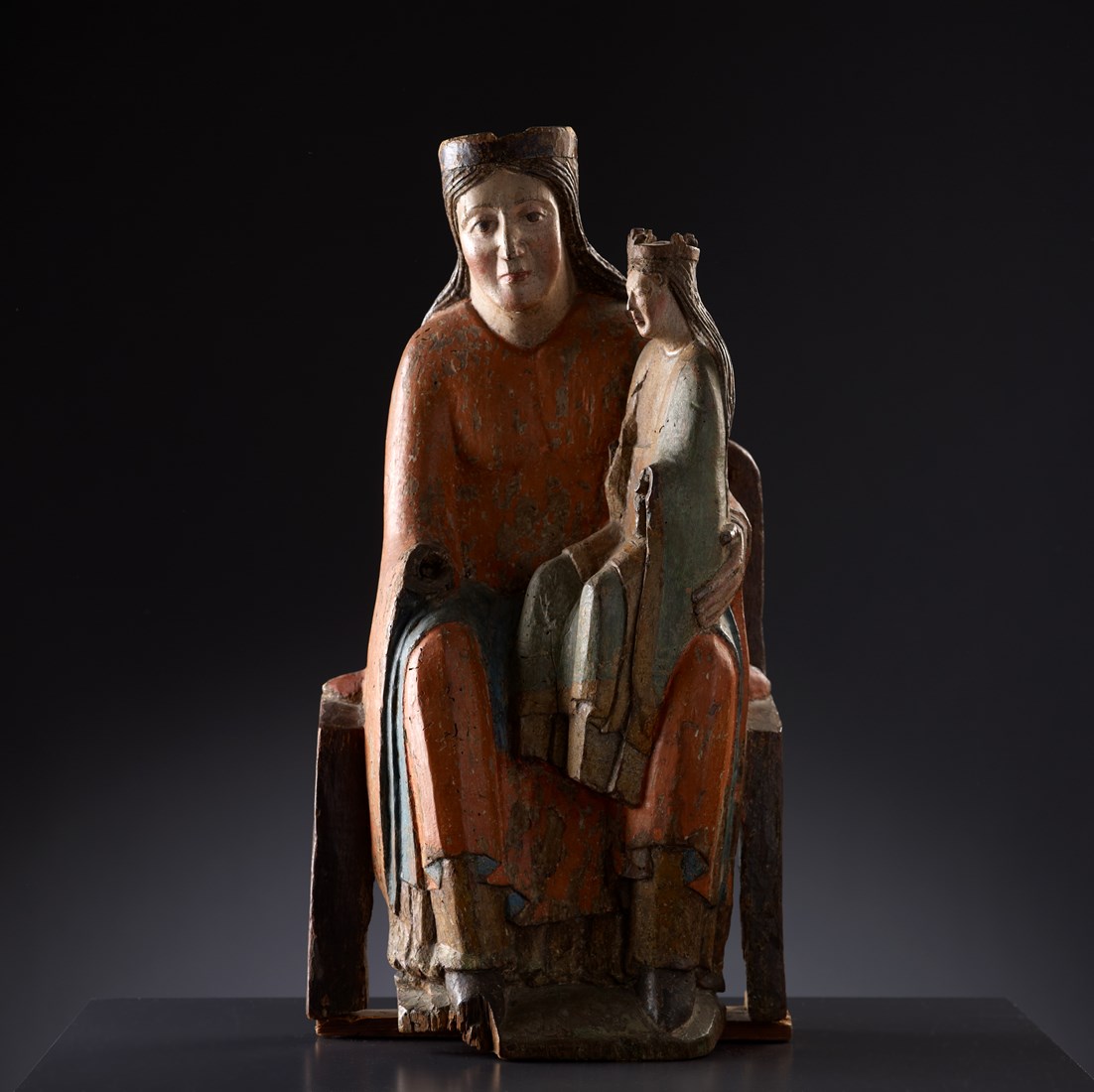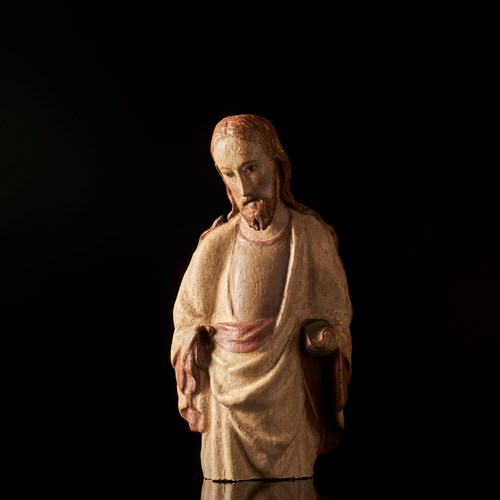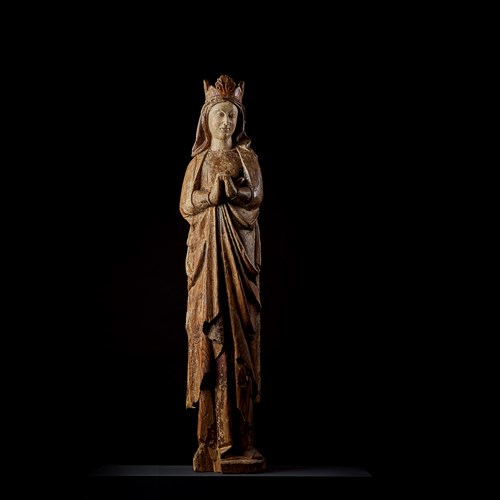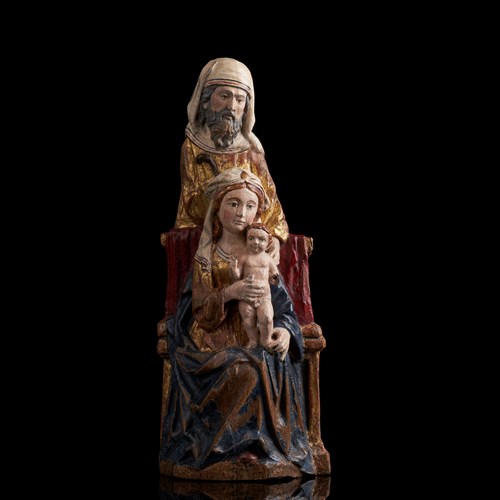18776

Saint Anne Trinity (the Child is missing)
Saint Anne Trinity
(the Child is missing)

Saint Anne Trinity
(the Child is missing)
(or perhaps a Sedes Sapientiae ?) polychromed wood Italy/South-Tyrol, Pustertal (?), ca. 1220 h: 65 cm C14 report K.I.K./I.R.P.A. Brussels
SOLD
phone 0032 3 314 90 34 – mobile 0032476 963 483.
ADDITIONAL PICTURES







READ
FULL DESCRIPTION
This Sitting figure is a sculpture from the last phase of the late Romantic period which was until now unknown: a crowned enthroned female figure with not yet aged face who on her left thigh holds another, emphatically young female figure sitting in an almost 90-degree angle, also crowned. At first glance, because of the missing underarm, this figure suggests that this arm originally supported a further figure – maybe standing. In the postulated case, the assumption of a standing Christ child would be an exceptionally early representation of a St Anne with the Virgin and Child, as the oldest proof of a figurative version of this type of devotional imagery dates from the 13th century: at the same time as the stronger autonomy of the urban middleclass life and the increasing of the societal needs relating to this – such as education – the veneration of the Mother of the Mother of God – although only named in apocryphal sources – Saint Anne, also increased, whereby in the late medieval period, as a result of the early humanist scholarship, popular Saint Anne Brotherhoods emerged, and Saint Anne masses were celebrated.
In 1439, the Council of Basel pronounced in favour of the belief and doctrine, which had already been advocated earlier by many authors, but never officially sanctioned, that in view of her purpose as Mother of God, the Virgin had been received in the womb of her mother without original sin. Especially among contemplative mystics in the milieu of the Franciscan Order, this view was intensively shared, and Pope Sixtus IV Rovere, who emerged from this milieu, introduced the Feast in honour of the ‘Immaculate Conception’ in 1483.
Of the three types of Saint Anne with Virgin and Christ Child representation modes differentiated by Hans Aurenhammer senior (in his Lexikon der christlichen Ikonographie, Bd. 1, Vienna 1959-1967, pages 146-149), this fragment of a sculpture group belongs – on the basis of the fracture point probably standing postulated missing Christ Child – to the oldest (first) type.
Since in the present group of figures, no traces of a standing sculpture can be found at the left upper leg of the large enthroned figure, it can be assumed that both the missing lower arm of the larger figure as well as both lower arms of the smaller figure may indicate that the sculpture was could have been intended to be a Saint Anne and Virgin group, which possibly held an open book, as “Sedes sapientiae” (meaning Seat of Wisdom): especially with the emergence of a stronger educational system in the earlier societal systems, these Saint Anne and Virgin representations, which present – particularly in the late-baroque – an example of the “Education of the Virgin” with a Virgin being taught to read by Saint Anne as a meaningful example to be followed.
Iconography
It was already pointed out and clarified in the introduction to the traditional variants of the visual representation of the Saint Anne with Virgin and Christ Child, that this sculpture would obligatorily have had a standing Christ Child opposite to the Mother of God Mary, in the form of a crowned girl, sitting on the left upper leg of Saint Anne, as the technological findings of this fragmented group of figures exclude another representation of the Christ Child – for instance as a sitting figure. Independently from the technological findings and from possible, not yet clearly clarified questions about the authenticity of the status of the polychrome, it can be reliably stated that this fragmented group of figure shows striking individualisms: both Saint Anne (!) and the Virgin are represented as being crowned, whereby the lily-shaped “pinnae” (the prongs on the crown in the shape of lilies) used for the figure of the Virgin (also originally assumed for Saint Anne) could have been executed in the same manner as for the childlike figure of the Virgin. Even this iconographic characteristic alone is totally unusual, because – if at all in this type of theme – only the Virgin -
in her mystical capacity as “Queen of Heaven” is shown as crowned. Not only the fact that the Mother of the Virgin, Saint Anne, is also crowned in this sculptural group, but also the similar crowns, and the long flowing hair with an almost sensual presence (!) as well as the concordant design of the physiognomy of the design of the faces show: the long oval contoured shape of the head is not only characteristic for the sculptural differentiation of the individual faces (for this, see also the characterising text under “Style”) but equally the reflective gaze and the related inward poise of the emotional expressions. Although the extensive mirroring of the surface characteristics of the garments emphasises the plastic volumes of the sitting figures arranged at right angles, the differentiation of the garment surfaces and garment lining on the one hand, and the intimated trimmings suggest a real “courtly” dress. In its modest but, thanks to the spiral endings of the corner pillars (which are still present only on the right), decorous shape, the throne is equally a representative item of furniture. Because of the absence of the Christ Child, it can still be postulated that, in accordance with Saint Anne and the Virgin, he should also have had to be crowned. With respect to the probably more correct interpretation of this group of figures as a “Sedes sapientiae”, and in view of the apparent relatively early date of this theme, it is possible to postulate that it is an obvious assumption that the original purpose in context was for a grammar school or at least an educational institution directed by clergy – for instance, a monastery.
The Throne was hollowed out at the back in an even manner and then covered, as the remains of the dowel holes show.
This side was later severely cut, in the upper part there are remains of sooting, which suggests veneration with candles. These observations allow for the presumption of use of the Throne as a reliquary.
Material.
Lime wood, full-round carved with remnants of the polychrome
A C-14 analysis was carried out by the K.I.K./I.R.P.A. , which dates the wood between 1155 and 1260.
Dimensions
Height 58.5 cm
Width 31.3 cm
Depth 21 cm
Damages
The right hand of Saint Anne, both hands of the Virgin and her feet are missing. Both crowns are partly scuffed. The plinth shows larger breaks.
Few original remains of polychrome.
Exhibition
2016 & 2017: ‘Für Salzburg bewahrt’ , Bergbau- & Gotikmuseum, Leogang, Austria
Provenance
Private collection Luc De Backker
In 1439, the Council of Basel pronounced in favour of the belief and doctrine, which had already been advocated earlier by many authors, but never officially sanctioned, that in view of her purpose as Mother of God, the Virgin had been received in the womb of her mother without original sin. Especially among contemplative mystics in the milieu of the Franciscan Order, this view was intensively shared, and Pope Sixtus IV Rovere, who emerged from this milieu, introduced the Feast in honour of the ‘Immaculate Conception’ in 1483.
Of the three types of Saint Anne with Virgin and Christ Child representation modes differentiated by Hans Aurenhammer senior (in his Lexikon der christlichen Ikonographie, Bd. 1, Vienna 1959-1967, pages 146-149), this fragment of a sculpture group belongs – on the basis of the fracture point probably standing postulated missing Christ Child – to the oldest (first) type.
Since in the present group of figures, no traces of a standing sculpture can be found at the left upper leg of the large enthroned figure, it can be assumed that both the missing lower arm of the larger figure as well as both lower arms of the smaller figure may indicate that the sculpture was could have been intended to be a Saint Anne and Virgin group, which possibly held an open book, as “Sedes sapientiae” (meaning Seat of Wisdom): especially with the emergence of a stronger educational system in the earlier societal systems, these Saint Anne and Virgin representations, which present – particularly in the late-baroque – an example of the “Education of the Virgin” with a Virgin being taught to read by Saint Anne as a meaningful example to be followed.
Iconography
It was already pointed out and clarified in the introduction to the traditional variants of the visual representation of the Saint Anne with Virgin and Christ Child, that this sculpture would obligatorily have had a standing Christ Child opposite to the Mother of God Mary, in the form of a crowned girl, sitting on the left upper leg of Saint Anne, as the technological findings of this fragmented group of figures exclude another representation of the Christ Child – for instance as a sitting figure. Independently from the technological findings and from possible, not yet clearly clarified questions about the authenticity of the status of the polychrome, it can be reliably stated that this fragmented group of figure shows striking individualisms: both Saint Anne (!) and the Virgin are represented as being crowned, whereby the lily-shaped “pinnae” (the prongs on the crown in the shape of lilies) used for the figure of the Virgin (also originally assumed for Saint Anne) could have been executed in the same manner as for the childlike figure of the Virgin. Even this iconographic characteristic alone is totally unusual, because – if at all in this type of theme – only the Virgin -
in her mystical capacity as “Queen of Heaven” is shown as crowned. Not only the fact that the Mother of the Virgin, Saint Anne, is also crowned in this sculptural group, but also the similar crowns, and the long flowing hair with an almost sensual presence (!) as well as the concordant design of the physiognomy of the design of the faces show: the long oval contoured shape of the head is not only characteristic for the sculptural differentiation of the individual faces (for this, see also the characterising text under “Style”) but equally the reflective gaze and the related inward poise of the emotional expressions. Although the extensive mirroring of the surface characteristics of the garments emphasises the plastic volumes of the sitting figures arranged at right angles, the differentiation of the garment surfaces and garment lining on the one hand, and the intimated trimmings suggest a real “courtly” dress. In its modest but, thanks to the spiral endings of the corner pillars (which are still present only on the right), decorous shape, the throne is equally a representative item of furniture. Because of the absence of the Christ Child, it can still be postulated that, in accordance with Saint Anne and the Virgin, he should also have had to be crowned. With respect to the probably more correct interpretation of this group of figures as a “Sedes sapientiae”, and in view of the apparent relatively early date of this theme, it is possible to postulate that it is an obvious assumption that the original purpose in context was for a grammar school or at least an educational institution directed by clergy – for instance, a monastery.
The Throne was hollowed out at the back in an even manner and then covered, as the remains of the dowel holes show.
This side was later severely cut, in the upper part there are remains of sooting, which suggests veneration with candles. These observations allow for the presumption of use of the Throne as a reliquary.
Material.
Lime wood, full-round carved with remnants of the polychrome
A C-14 analysis was carried out by the K.I.K./I.R.P.A. , which dates the wood between 1155 and 1260.
Dimensions
Height 58.5 cm
Width 31.3 cm
Depth 21 cm
Damages
The right hand of Saint Anne, both hands of the Virgin and her feet are missing. Both crowns are partly scuffed. The plinth shows larger breaks.
Few original remains of polychrome.
Exhibition
2016 & 2017: ‘Für Salzburg bewahrt’ , Bergbau- & Gotikmuseum, Leogang, Austria
Provenance
Private collection Luc De Backker




